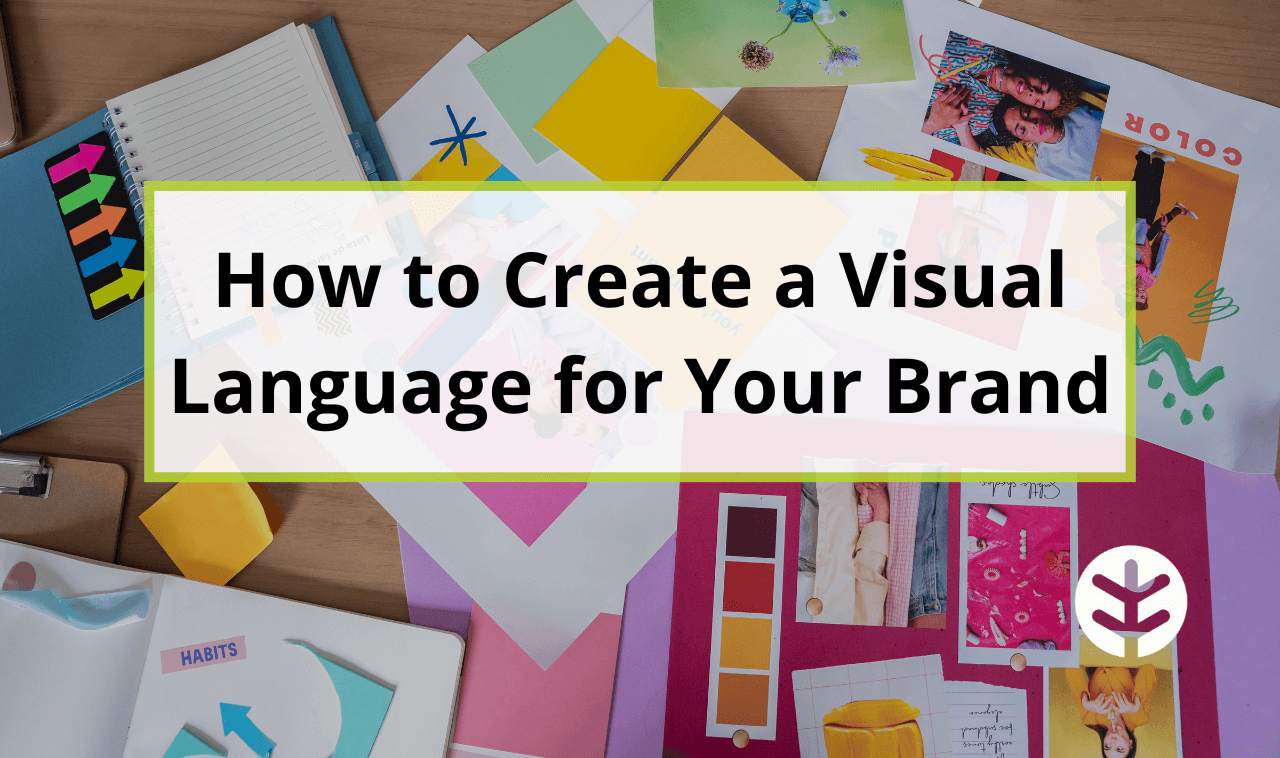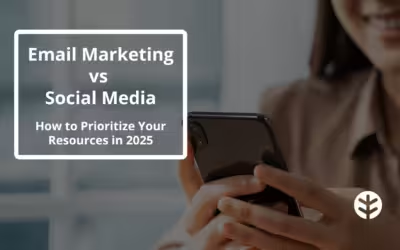As a small business owner in the health and wellness industry, you understand the power of meaningful client communication. Of course, written language plays a significant role in these communications, whether email, social media posts, blog posts, etc. But what about visual language?
Visual language is a powerful tool that can help you strengthen your brand identity, communicate authenticity, evoke deep emotions, and establish lasting connections with your clients. However, many small businesses never get the chance to fully understand or unlock the potential of visual language – until now.
In the following article, we’ll introduce you to visual language and its key role in branding and communication. We’ll explore the key components of visual language, delve into the psychology behind why it works, walk you through a step-by-step process for creating a unique visual language for your brand, and more.
It’s time to unlock the power of visual language for wellness businesses and elevate your brand with the tools you need to create an authentic visual identity that resonates with your target audience.
Table of Contents:
What is Visual Language?
Simply put, visual language is the language of the eyes. While verbal language consists of words and sounds to communicate, visual language consists of graphical elements, illustrations, photography, and other visual means of communication. Together, these visual elements represent your brand’s identity.
Beyond setting you apart from your competition, developing a strong visual language helps you establish and maintain a consistent, cohesive brand identity across various channels, from websites and social media to studio decor and physical promotional materials.
A well-defined visual language will help you clearly communicate your brand values, personality, and niche effectively, making you more memorable and appealing to your target audience.
Putting in the time and energy to develop a visual language for your wellness brand is well worth the effort for several reasons, including:
- A clear understanding of brand vision: Your visual language ensures that everyone who touches your brand — from volunteers and assistants to third-party vendors — has a shared sense of its style, core values, and goals.
- Shared rules to abide by: Establish firm guidelines for your visual language to help maintain brand coherence.
- Consistent branding across channels: By applying your visual language consistently across your platforms, you create a unified brand experience for your customers.
- A more recognizable brand: A distinctive visual language makes your brand more recognizable and memorable, helping you stand out in a crowded market.
Examples of Visual Language Components
While the list of components of visual language is vast, there’s no need to be overwhelmed. Let’s take a closer look at some essentials that contribute to a brand’s visual language (you’ll likely recognize most of them!):
- Color: Color palettes (a specific collection of colors) evoke emotions and convey brand personality.
- Shapes: Specific shapes and forms can communicate brand attributes and create visual harmony across designs.
- Symbols: Logos, icons, and other symbolic elements help create a strong visual identity and make your brand easily recognizable.
- Typography: Beyond the words they form, your choice of font(s) and their arrangement shape your brand’s visual language and the readability of your verbal language.
- Photography: Your photographic imagery, particularly of subject matter, types of focus, and light, can evoke strong personal connections with your brand.
Download Our Step-by-Step Guide to Brand Development
The Importance of Visual Language in Communication
In a world where your clients are constantly bombarded with information, visual communication has the power to cut through the noise and create a lasting impression. Even before a potential customer reads a single word of your messaging, strong visual language can convey the essence of your business and establish a deep emotional connection with them.
With online platforms making it faster and easier to bring your brand to life (like OfferingTree, for example), you have the opportunity to reach a wider audience and engage with them through visually compelling content. Whether over email, a sales page, or anything else, your visual language can often speak louder than your words.
In this context, a well-defined visual language is more than pretty colors and appealing aesthetics — it becomes a powerful tool for storytelling, building brand recognition, and fostering customer loyalty. With this in mind, always consider the following when establishing and evaluating your own visual language:
- Emotional connection: Visual language can evoke emotions and create a sense of well-being, which is particularly important for health and wellness brands.
- Brand differentiation: A unique visual language helps you stand out in a crowded market and establish a distinctive brand identity.
- Consistency and trust: Consistent application of visual language across all touchpoints makes you look more professional, building trust and credibility.
Psychology Behind Visual Language
How do our brains process and respond to visual stimuli? Studies have shown that visual information is processed faster, more immediately, and more efficiently than text alone, making it a powerful tool for communication and persuasion.
You know that saying “a picture is worth a thousand words”? Yep. That.
While you don’t have to take Psych 101 to wield the tools at play here, it’s worthwhile to complement your practice, business, and brand development with a quick dive into some basic psychological principles that underpin the effectiveness of visual language:
- Cognitive fluency: Visuals that are easy to process and understand are more likely to be perceived as trustworthy and appealing.
- Emotional impact: As mentioned earlier, images and colors can evoke strong emotional responses, influencing how people perceive and remember a brand.
- Attention and memory: Visually striking visual elements are more likely to capture attention and create lasting memories, enhancing recall.
Creating a Visual Language for Your Brand
Finally! It’s time to create the visual language for your health and wellness business. This section will guide you through 6 key steps to develop a cohesive and compelling visual language that resonates with your target audience, sets your brand apart from competitors, and is truly authentic to you.
Step 1: Understand Your Service or Product
To create a visual language that effectively represents your brand, you must first possess (or develop) a deep understanding of your service or product. Now, here, it’s not enough to intuit the specifics or go on “feel.”
This step is very left-brained and involves objectively analyzing the core features, benefits, and unique selling points of your wellness offerings. This information will help guide the development of your visual language further down the road.
Here are some tips to take to simplify this part of the process:
- Identify your key attributes: Determine the most important characteristics of your wellness products or services that set them apart from competitors.
- Define your target audience: Understand the needs, preferences, and aspirations of your ideal customers to create a visual language that appeals to them.
- Identify your core visual elements: We covered these earlier, but they’re so important we’re bringing them up again. Collect your colors, shapes, symbols, typography, photography, and other core visual elements. Broad strokes are fine at this point (you’ll refine them later).
- Align your visual language with your brand: Compare all this information with your brand, business, and offerings. Do they align and accurately reflect the nature and benefits of your wellness offerings? Hold on to what does and set aside what doesn’t!
Step 2: Understand How Your Brand Is Perceived
Next, gaining insights into how your target audience perceives your brand is crucial. Here, you’ll find out if your perception of your brand (or how you’d like it to be perceived) compares to the current reality.
Have no fear! Clarity is the key to a healthy brand. To achieve this, you’ll want to conduct research, use web analytics tools, and gather client feedback to identify the thoughts, feelings, and biases associated with your brand.
- Market research: Use surveys, focus groups, web analytics, and social media to gather insights into how your target audience perceives your brand.
- Identify the emotions associated with your brand: Track the feelings and associations that your brand evokes in your customers’ minds, paying close attention to words that are used often and the emotions that come through when they talk about your business.
- Compare your brand perception with competitors: Analyze how your brand is perceived in relationship to your competitors to identify opportunities for differentiation.
Step 3: Create a Glossary for Your Visual Language
This step is fun (at least, we think so). Once you clearly understand your brand perception, it’s time to create a glossary for your visual language. For a refresher, a glossary is an alphabetical list of terms or words relating to a specific subject, the subject here being your brand. More specifically, your brand’s visual language.
Here, you will collect and define the key visual elements that will form the foundation of your brand’s visual identity. Luckily, you’ve already gathered some of these elements in Step 1. Now, we’re going to use what we’ve learned in Step 2 to make some informed decisions:
- Define your color palette: Select a set of colors that reflect your brand personality and evoke the desired emotions in your target audience. Are you flowing with cool blues and greens? Full of yellow and red fire? Pleasant pastelles? Rustic rusts and browns? These will make up your palette.
- Choose your typography: Determine the fonts and typographic styles that align with your brand’s personality. While it may be tempting to put a lot of personality into your font choice, be sure to prioritize readability at different sizes and across platforms.
- Establish your iconography, illustrations, and photography: Create a library of icons, illustrations, and photography visually representing your brand’s key concepts and values.
Step 4: Clearly Define Your Design Principles
Establishing a set of design principles is essential to ensuring consistency and coherence in your visual language. Design principles are the defining rules and guidelines that govern how your visual elements should be used in all your content creation.
Think of them as your visual language playbook. It doesn’t have to be complicated at first. In fact, you should start simple. The more you work with your visual language, the more your principles will grow and change. But at this stage, be sure to organize them into these three fundamental categories:
- Layout and composition principles: Establish rules for the arrangement and spacing of visual elements to create a consistent look and feel.
- Image and photography style: Set guidelines for the type of images and photography that align with your brand’s visual language and examples of what kinds of images do not align.
- Hierarchy of visual elements: Establish a clear order of importance of visual elements to help you prioritize what goes where in a layout, especially to guide the user’s attention.
Step 5: Document Your Processes for Scalable Use
Whether you do all your design work alone or have help on the side, a brand guidelines document will keep your visual language consistent across all touchpoints. That means creating a comprehensive document that collects all your key strategic findings throughout this process, outlines all aspects of your visual language, and clearly explains how it should be used.
While, like your design principles, this document will grow and change over time, here are some fundamental elements to get you started:
- Create a brand style guide: A detailed document that includes all the critical elements of your visual language and how to use them.
- Provide examples and templates: Show your visual language with examples and templates displaying how your brand is applied across different platforms and mediums.
- Make your guidelines easily accessible: Keep them simple, clear, and organized to ensure that anyone using this document can consistently apply your visual language (you never know how big your business will get!).
Step 6: Stick to Your Rules (Unless …)
Rules are made to be broken, right? Well, yes and no. Indeed, adherence to the guidelines you’ve established for your visual language is essential to maintaining consistency and building brand recognition.
However, it’s equally important to recognize that your visual language may need to evolve to stay relevant and adapt to changing market conditions and client trends. That may mean you’ll need to throw out some old rules to make room for new ones, change up your color palette, and more.
To keep your visual language fresh, vibrant, and effective:
- Regularly review and update your guidelines: Periodically assess your visual language. This means market research, audience research, and gut-checking with yourself to ensure that it remains effective and relevant.
- Be open to evolution: You are evolving, and so is your business. Your visual language should follow suit. Be willing to adapt and refine your visual language as your brand evolves while maintaining its core identity.
- Know when and how to break the rules: Like the rest of your business, your visual language is ultimately under your control. If a situation arises where you know breaking a rule or principle in a specific situation will achieve a greater end, stronger connection, and more authentic effect, give yourself permission to go with it.
Download Our Marketing Checklist for Growth
Challenges and Considerations for Developing Visual Language
Even when you follow a clear path forward (like the one we’ve laid out here), developing a visual language for your wellness brand can be challenging. It requires careful consideration, planning, creativity, strategy, research, trial and error, vigilance, flexibility, practice, and a whole lot of patience. But it’s worth it.
While no two business owners will have the same journey to developing their unique visual languages, there are some common challenges and considerations that nearly everyone will face. In this section, we’ve laid out some of them in a little cheat sheet to help you navigate the process like a pro.
Visual Language Challenges
- Ensuring consistency across all touchpoints and mediums
- Differentiating your brand from competitors in a crowded market
- Finding the right number/amount of visual elements (not too many/not too few)
- Adapting your visual language to different contexts and audiences
Visual Language Considerations
- Conduct thorough research: Invest time in understanding your target audience, competitors, and industry trends.
- Collaborate with professionals: Collaborate with experienced designers and branding experts who can help you translate your brand values into a cohesive visual language.
- Test and refine: Regularly assess the effectiveness of your visual language through user testing and feedback; be open to making adjustments as needed.
- Keep it simple: Strive for simplicity, clarity, and consistency. A clean, uncluttered visual language can be more impactful and memorable than an overly complex one.
Create a Visual Language for Your Business with OfferingTree
Developing a visual language for your wellness brand is an invaluable investment that pays off in stronger client connections, brand recognition, and overall business growth.
By understanding the core principles and thoughtfully applying the steps outlined here, you’ll create a visual identity that is not only cohesive and compelling but truly represents your brand. Embrace the power of visual language to elevate your communications and leave a lasting impression on your audience.
Our blog offers more helpful tips and small business advice. You can also browse our webinar library for educational presentations from industry experts.



![How to Ask Customers for Reviews [with Email Templates]](https://www.offeringtree.com/wp-content/uploads/2021/10/how-to-ask-for-customer-reviews-cover-image-400x250.avif)
